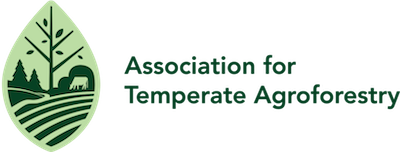| |
Hello Visitor,
Welcome to the Winter 2020 version of the Temperate Agroforester. The newsletter welcomes contributions for future issues and input or feedback about anything that you read in this issue.
Christine Nieman, Steve Gabriel, Callie Maron, and Jennifer Ghigiarelli Editors - Temperate Agroforester
Events
Call to Action
AFTA needs you! We need your research updates, blog posts, news items and other information to inform our followers. Contact: Andres Anchondo. We are also looking for volunteers to help with membership engagement and website content. Volunteer today to help keep AFTA moving foward.
Membership
Are you a member of AFTA? If not consider joining by clicking here. Your membership gives you access to the members-only area, discounts on conference registration, and helps support AFTA's mission to promote agroforestry.
Contents
Mounika Pudota, Michelle Mbia, Srinivasa Rao Mentreddy and Dedrick D. Davis. Alabama A&M University
 Agroforestry is defined as the integration of trees and agricultural crops or animals in a single unit of land for the effective and efficient utilization of natural resources. Agroforestry systems have been considered as a sustainable and resilient alternative agriculture practice to ameliorate soil conditions and enhance crop productivity. Soil temperature and moisture influence many soil physical, chemical and biological processes that occur in soil. These processes include infiltration, hydraulic conductivity, greenhouse gas production, soil microbial activity, seed germination, and plant growth. Agroforestry systems can influence soil temperature and moisture by altering microclimate conditions such as light, temperature, wind speed and relative humidity. Plant size, architecture, row width, and orientation can cause spatial and temporal variations in soil temperature and moisture in agroforestry systems due to shading effects (Horton et al., 1984; Horton, 1989; Ham and Kluitenberg, 1993; Colaizzi et al., 2010; Pieri, 2010; Mittelbach and Seneviratne, 2012). Furthermore, soil temperature and moisture fluctuations in an agroforestry system can be complicated due to the various components in a single system such as deep tree roots, shallow roots of crop species, and complementarity and facilitation effects among the crops (Niether et al., 2017). Knowledge of the near surface spatial and temporal variations in soil temperature and moisture in agroforestry system can potentially enhance our understanding of soil’s physical, chemical, and biological processes in these systems.
Read More
Anna Plattner, General Manager, American Ginseng Pharm
 American ginseng (Panax quinquefolius) is arguably the most valuable non-timber forest crop in Eastern North America. For three hundred years, this native understory herb has been harvested and sold to East Asia for use as medicine. As wild American ginseng plants do not replace themselves until they have reached an average age of ten years or older (McGraw 2017), centuries of harvest have left us with fragmented wild populations. Today, the vast majority of American ginseng on the market is cultivated in farm fields under shade cloth or in tilled garden beds underneath the shade of a forest canopy. However, this high-density production is unnatural and stressful for ginseng, resulting in outbreaks of fungal pathogens that kill the plants. Even with regular applications of fungicides and pesticides, plants rarely survive more than a few years, and the subsequent organic value of the ginseng root is then compromised.
Read More
Jacob Grace, Savanna Institute

The Savanna Institute’s 2019 Perennial Farm Gathering (PFG) was held Dec. 6-7th at the Sinsinawa Mound Center near Dubuque, Iowa (Figure 1). This year’s gathering had over 235 attendees and featured a variety of presentations, workshops, and networking opportunities for Midwestern agroforestry enthusiasts.
Read More
Margaret Bloomquist and Chloe Moore, NC Alternative Crops and Organics Program, Dept. of Horticultural Science, North Carolina State University
 The WNC woodland stewards celebrated our 4th year growing together in the forests of western North Carolina (WNC) in December 2019. Highlights from the season included new plantings, expanded production, and data collection for ramp and ginseng research projects.
Read More
Gary Bentrup, USDA National Agroforestry Center, Lincoln, NE
 Plant pollination by animals is a critical ecosystem service and an estimated 85% of the world’s flowering plants depend on animals, mostly insects, for pollination (Ollerton et al. 2011). Insect pollination is essential to food security and roughly 35% of global crop production is dependent on pollination by animals (Klein et al. 2007; Eilers et al. 2011). Globally, insect pollinators are in decline, with some estimates that 40% of invertebrate pollinator species may be at risk of extinction worldwide due to threats such habitat fragmentation and loss, use of pesticides, and diseases and parasites (IPBES 2016). By adding structural and functional diversity to agricultural landscapes, agroforestry may be able to support pollinator conservation and pollination services.
Read More
|
|





